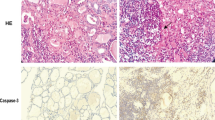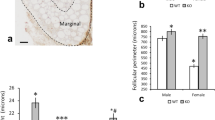Abstract
Purpose
In radioiodine therapy the “stunning phenomenon” is defined as a reduction of radioiodine uptake after diagnostic application of 131I. In the current study, we established an in vitro model based on the “Fisher rat thyrocyte cell line no. 5” (FRTL-5) to investigate the stunning.
Methods
TSH-stimulated FRTL-5 cells were incubated with 131I. Time-dependent 131I uptake and the viability of FRTL-5 cells were evaluated at 4–144 h after radioiodine application. All data was corrected for number of viable cells, half life and 131I concentration. Sodium iodide symporter (NIS) and the housekeeping gene (β-actin, GAPDH) levels were quantified by quantitative polymerase chain reaction (qPCR). Additionally, immunohistochemical staining (IHC) of NIS on the cell membrane was carried out.
Results
FRTL-5 monolayer cell cultures showed a specific maximum uptake of 131I 24–48 h after application. Significantly decreased 131I uptake values were observed after 72–144 h. The decrease in radioiodine uptake was correlated with decreasing mRNA levels of NIS and housekeeping genes. In parallel, unlike in controls, IHC staining of NIS on FRTL-5 cells declined significantly after 131I long-term incubation.
Conclusions
It could be demonstrated that during 131I incubation of FRTL-5 cells, radioiodine uptake decreased significantly. Simultaneously decreasing levels of NIS mRNA and protein expression suggest a NIS-associated mechanism. Since mRNA levels of housekeeping genes decreased, too, the reduced NIS expression might be provoked by a cell cycle arrest. Our investigations recommend the FRTL-5 model as a valuable tool for further molecular biological investigations of the stunning phenomenon.





Similar content being viewed by others
References
Cholewinski SP, Yoo KS, Klieger PS, O'Mara RE. Absence of thyroid stunning after diagnostic whole-body scanning with 185 MBq 131I. J Nucl Med. 2000;41:198–02.
Hilditch TE, Dempsey MF, Bolster AA, McMenemin RM, Reed NS. Self-stunning in thyroid ablation: evidence from comparative studies of diagnostic 131I and 123I. Eur J Nucl Med. 2002;29:783–8.
Lassmann M, Luster M, Hanscheid H, Reiners C. Impact of 131I diagnostic activities on the biokinetics of thyroid remnants. J Nucl Med. 2004;45:619–25.
Lees W, Mansberg R, Roberts J, Towson J, Chua E, Turtle J. The clinical effects of thyroid stunning after diagnostic whole-body scanning with 185 MBq 131I. Eur J Nucl Med Mol Imaging. 2002;29:421–7.
Luster M, Sherman SI, Skarulis MC, Reynolds JR, Lassmann M, Hanscheid H, et al. Comparison of radioiodine biokinetics following the administration of recombinant human thyroid stimulating hormone and after thyroid hormone withdrawal in thyroid carcinoma. Eur J Nucl Med Mol Imaging. 2003;30:1371–7.
Medvedec M. Seeking a radiobiological explanation for thyroid stunning. Eur J Nucl Med. 2001;28:393–5.
Morris LF, Waxman AD, Braunstein GD. The nonimpact of thyroid stunning: remnant ablation rates in 131I-scanned and nonscanned individuals. J Clin Endocrinol Metab. 2001;86:3507–11.
Park HM, Perkins OW, Edmondson JW, Schnute RB, Manatunga A. Influence of diagnostic radioiodines on the uptake of ablative dose of iodine-131. Thyroid. 1994;4:49–54.
Urhan M, Dadparvar S, Mavi A, Houseni M, Chamroonrat W, Alavi A, et al. Iodine-123 as a diagnostic imaging agent in differentiated thyroid carcinoma: a comparison with iodine-131 post-treatment scanning and serum thyroglobulin measurement. Eur J Nucl Med Mol Imaging. 2007;34:1012–7.
Wu HS, Hseu HH, Lin WY, Wang SJ, Liu YC. Decreased uptake after fractionated ablative doses of iodine-131. Eur J Nucl Med Mol Imaging. 2005;32:67–73.
Verburg FA, de Keizer B, Lips CJM, Zelissen PMJ, de Klerk JMH. Prognostic significance of successful ablation with radioiodine of differentiated thyroid cancer patients. Eur J Endocrinol. 2005;152:33–7.
Dietlein M, Dressler J, Farahati J, Grunwald F, Leisner B, Moser E, et al. Procedure guidelines for radioiodine therapy of differentiated thyroid cancer (version 2). Nuklearmedizin. 2004;43:115–20.
Cooper DS, Doherty GM, Haugen BR, Kloss RT, Lee S, Mandel S, et al. The American Thyroid Association Guidelines Taskforce. Management guidelines for patients with thyroid nodules and differentiated thyroid cancer. Thyroid. 2006;16:109–42.
Gerard SK, Park HM. Stunning and I-123 Use for Diagnostic Whole Body Scanning. Thyroid. 2006;16:817.
Postgard P, Himmelmann J, Lindencrona U, Bhogal N, Wiberg D, Berg G, et al. Stunning of iodide transport by 131I irradiation in cultured thyroid epithelial cells. J Nucl Med. 2002;43:818–34.
Ambesi-Impiombato FS, Parks LAM, Coon HG. Culture of hormone-dependent functional epithelial cells from rat thyroids. Proc Natl Acad Sci U S A. 1980;77:3455–9.
Weiss SJ, Philip NJ, Grollman EF. Iodide transport in a continuous line of cultured cells from rat thyroid. Endocrinology. 1984;114:1090–8.
Grollman EF, Smolar A, Tombaccini D, Santisteban P. Iodine suppression of iodide uptake in FRTL-5 thyroid cells. Endocrinology. 1986;118:2477–82.
Eng PH, Cardona GR, Previti MC, Chin WW, Braverman LE. Regulation of the sodium iodide symporter by iodide in FRTL-5 cells. Eur J Endocrinol. 2001;144:139–44.
Leer LM, Ossendorp FA, de Vijlder JJM. TSH action on iodination in FRTL-5 cells. Horm Metab Res Suppl. 1990;23:43–6.
Weiss SJ, Philip NJ, Ambesi-Impiombato FS, Grollman EF. Thyrotropin-stimulated iodide transport mediated by cyclic AMP and dependent on protein synthesis. Endocrinology. 1984;114:1099–107.
Eskandari S, Loo DD, Dai G, Levy O, Wright EM, Carrasco N. Thyroid Na+/I− symporter. Mechanism, stoichiometry, and specificity. J Biol Chem. 1997;272:27230–8.
Meller B, Deisting W, Wenzel BE, Pethe A, Nadrowitz R, Meller J, et al. Increased Radioiodine Uptake of Thyroid Cell Cultures after External Irradiation. Strahlenther Onkol. 2006;182:30–6.
Bauer R. Physikalische Grundlagen der Radioiodtherapie. In: Radiojodtherapie bei Schilddrüsenerkrankungen. Indikationen – Ergebnisse – Nebenwirkungen. pp 3–21. Ed G Buttermann. Frankfurt: pmi;1987.
Wawschinek O, Eber O, Petek W, Wakönig P, Gürakar A. Bestimmung der Harniodausscheidung mittels einer modifizierten Cer-Arsenitmethode. Berichte der ÖGKC. 1985;8:13–5.
Studer H, Ramelli F. Simple goiter and its variants: euthyroid and hyperthyroid multinodular goiters. Endocr Rev. 1982;3:40–61.
Meller B, Haase A, Seyfarth M Richter E, Baehre M. Reduced radioiodine uptake at increased iodine intake and 131I-induced release of “cold” iodine stored in the thyroid. Nuklearmedizin. 2005;44:137–42.
Meller B, von Hof K, Genina E, Deisting W, Meller J, Richter E, et al. Effects of 123I and 131I diagnostic activities and radioiodine therapy on urinary iodine excretion in patients with differentiated thyroid carcinoma. Nuklearmedizin. 2005;44:243–7.
Schomacker K, Wellner U, Scheidhauer K, Gabruk-Szostak B, Fischer T, Steinbach J, et al. Relationship between properties of 131I therapy and radioiodine kinetics. Nuklearmedizin. 1996;35:175–80.
Nuchel C, Boddenberg B, Schicha H. The importance of the radioiodine test for the calculation of the therapeutic dose in benign thyroid diseases. Nuklearmedizin. 1993;32:91–8.
Spitzweg C, Joba W, Morris JC, Heufelder AE. Regulation of sodium iodide symporter gene expression in FRTL-5 rat thyroid cells. Thyroid. 1999;9:821–30.
Appelskog IB, Ammerpohl O, Svechnikova IG, Lui WO, Almqvist PM, Ekstrom TJ. Histone deacetylase inhibitor 4-phenylbutyrate suppresses GAPDH mRNA expression in glioma cells. Int J Oncol. 2004;24:1419–25.
Fareh J, Martel R, Kermani P Leclerc G. Cellular effects of beta-particle delivery on vascular smooth muscle cells and endothelial cells: a dose–response study. Circulation. 1999;99:1477–84.
Klett R, Puille M, Steiner D, Bauer R. Einfluss des Applikationsabstandes auf den thyreoidalen Uptake bei zweizeitiger Radiojodtherapie. Nuklearmedizin. 2000;39:A91.
Schumm-Draeger PM. Sodium/iodide symporter (NIS) and cytokines. Exp Clin Endocrinol Diabetes. 2001;109:32–4.
Arturi F, Presta I, Scarpelli D, Bidart J-M, Schlumberger M, Filetti S, et al. Stimulation of iodide uptake by human chorionic gonadotropin in FRTL-5 cells: effects on sodium/iodide symporter gene and protein expression. Eur J Endocrinol. 2002;147:655–61.
Arai M, Tsushima T, Isozaki O Demura H, Shizume K, Emoto N, et al. Effects of transforming growth factor alpha (TGF-alpha) on DNA synthesis and thyrotropin-induced iodine metabolism in cultured porcine thyroid cells. Eur J Endocrinol. 1995;132:242–8.
Acknowledgements
The authors thank Silvia Grammerstorf-Rosche, Angela Oldörp and Detlev Schult for technical assistance. This work was supported in parts by ‘Margarete Markus Charity Foundation’.
Author information
Authors and Affiliations
Corresponding author
Rights and permissions
About this article
Cite this article
Meller, B., Gaspar, E., Deisting, W. et al. Decreased radioiodine uptake of FRTL-5 cells after 131I incubation in vitro: molecular biological investigations indicate a cell cycle-dependent pathway. Eur J Nucl Med Mol Imaging 35, 1204–1212 (2008). https://doi.org/10.1007/s00259-007-0666-0
Received:
Accepted:
Published:
Issue Date:
DOI: https://doi.org/10.1007/s00259-007-0666-0




